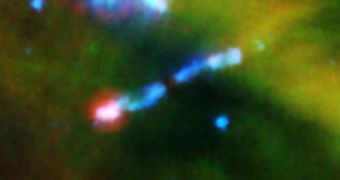According to the recent discoveries of a scientific investigation, it would appear that water ice and organic molecules are common place in the solar system, and especially on asteroids making their way among the planets.
Astronomers were able to make an impressive breakthrough in this field of research when they were able to demonstrate that a very young new star was capable of hosting chemical reactions that led to the destruction of water molecules on a stellar scale.
The study that led to this conclusion was conducted using the NASA Spitzer Space Telescope, an infrared observatory capable of penetrating through thick layers of stellar dust and gas that usually surround newborn stars in their home nebulae.
The red-colored section of the gas jet in the lower left portion of the attached image represents iron that has been heated by shock waves emanating from the newborn star. Sulfur and dust are also heated in the same region of the nebula.
The blue-colored portions of the image are represented by hydrogen molecules, also heated by shock-waves from the new star. These reactions may indicate why water ice molecules exist in our own solar system, Daily Galaxy reports.
In April 2010, two research teams identified the first asteroid around the Sun that contained water ice and organic particles. Now, that the second such asteroid has been found, experts are beginning to consider the possibility that this is actually the norm in the solar system.
In other words, it could be that most asteroids revolving around the Sun feature these two types of particles on their surface. This would explain why ancient comets that struck Earth brought the seeds of life here.
Asteroid 24 Themis and 65 Cybele are the only two space rocks that have been demonstrated beyond a reasonable doubt to house ice and particles or chemicals that could underlie organic chemistry.
The discoveries also bear additional implications, especially as far as the definitions separating asteroids from comets go. While the former are considered to be barren space rocks, the other are thought to be entirely icy, with only a rocky core.
Now, that asteroids are demonstrated to carry ice too – albeit a lot less than a comet – these definitions may need to be reconsidered. Given the number of asteroids that slammed Earth in the past, it may be that these space rocks also played an important role in the development of early life here.
Until now, this role had been exclusively reserved to comets.

 14 DAY TRIAL //
14 DAY TRIAL //